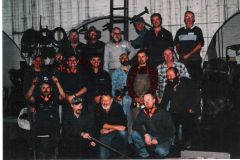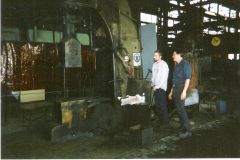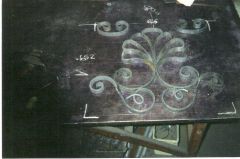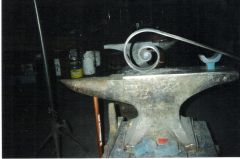
AndrewOC
Members-
Posts
455 -
Joined
-
Last visited
Content Type
Profiles
Forums
Articles
Gallery
Downloads
Events
Everything posted by AndrewOC
-
Some in the Trad. Tools Group have experimented with vinegar and citric acid solution (separately of course). There have been some very useable results, especially good for cheap/free old files that aren't much use as obtained. Andrew O'C ps the worst trick i've seen with a file is a historical fencing boffin trying to 'wipe' nicks out of his sword, waving the file over like it was emery paper! He is an office worker after all ; )
-
A No-Mar, Low Stretch Bending Fixture
AndrewOC replied to Nakedanvil - Grant Sarver's topic in Presses
Ah we have split personality when it comes to adopting standards of the world! Part of the psyche. I've had bit of an Imperial measures morning. And yes 25.4mm plate would be easier for us to find regs Andrew -
A shoulder will stop tooling driving deeper into any hole. When bouncing around is a problem i've thought about (but not been able to try..) some solutions. 1 ridiculously long tool shank (eg half way to the floor) that works as a counterweight 2 some kind of quick release system that bears on the underside of the heel. I'm thinking a tapered wedge thru the tool shank, or nut on thread bearing against coil spring to underside of heel. ...discuss! Andrew O'C
-
A No-Mar, Low Stretch Bending Fixture
AndrewOC replied to Nakedanvil - Grant Sarver's topic in Presses
Ah youse Americans and bacon! Great idea Grant, thanks for posting it. The workshop i work in has a 60 ton hand pumped hydraulic press, i'll eventually build one for it. What thickness steel would you suggest for the floor and sides of the box? It would be used on top of a platen thats 'bout 1-1/8" thick. Ta Andrew O'C -
Hammer pad between hammer and foundation
AndrewOC replied to Ed Thomas's topic in Power Hammers, Treadle Hammers, Olivers
yeah, i blew out 1 1/4" dia, 2 ft deep holes once that were half full of water... erky perky! Used specs, but i looked like a coal miner/ oil driller. Andrew O'C -
Are any two the same?? Neat swage block stands, i've made a similar pattern in ply (experimental). Andrew O'C
-
Does sound like a good idea urnesbeast. As the guys above mentioned bar stock significantly shorter the full length is more efficiently stored other ways. I'd also consider lining your 'gap wall' with ply, also u could drill the holes after assembly; just transfer stud centers to the outside in pencil. At my first place of employment, the steel rack was a quite large conventional open grid of supports, the whole assembly buried under the draftsman's office (a mezzanine floor jutting over the workshop). This made for a right nightmare when we racked a truckload of stock; it would be easy to get the first half of the bars in, then as you slid it more the end would sag and catch on every thing! Another way around this was suggested to me. One fellow i know had cee shaped trays that contained the more unruly light section steel. hope this helps, Andrew O'C ps i just re-read and see your idea means an open faced rack. duh! me. any way these are far easier, its just that one tends to leave the floor area in front clear which may cost u space u don't have. Again i agree with the other guys, that has potential to bust a wood frame wall, ok if little stuff is put on it.
-
Yus, I have an anvil almost exactly the same. My plan is to polish up the high spots of the sway-back and forge on them. have fun Andrew O'C
-
Building Tire Hammer
AndrewOC replied to Countryforge's topic in Power Hammers, Treadle Hammers, Olivers
yeah, like a ton of feathers and a ton of bricks ; ) (sorry couldn't help it) Seriously though, my spring hammer has a banana shaped piece of 1 1/4 plate bolted onto the existing cast counter weight of the crank plate. Unfortunately it's not running yet so i can't comment on performance... Andrew O'C -
Hi ya Kendrick, I imagine they (sash weights) would be handy to people building sand/concrete filled home-made power hammer components like the tup and anvil. Also use as portable weights, like weighing down a leg visce base, or pole for a oliver hammer or pole lathe. More fun might be using for trebuchet counterweight (or projectiles?)... ; ) anyway, as i'm sure u know 'keep a thing, it's use will come' Andrew.
-
Loading a Large Drill Press
AndrewOC replied to kubiack's topic in Drills, Post drills, Mag drills, etc
Yep kubiack, knocked up in a hurry for this pick up. The wheels have auto front spindles/ steering knuckles in them, they were screwed to timber beams which had various packing pieces nailed on to support the hammer frame. worked well enough to move, gently, until being nudged with a forklift at the workshop. I've now made steel girder axles to suit these wheels and spindles, stay tuned for photo... Apart from the flimsiness of the timber version, the only other problem was the base plate being to low and catching on the horse float ramp during loading. It was all fun. New steel frame has a steering set and shall be adaptable to other machines, just have to remind myself NEVER to drive it down the road! Andrew. -
Loading a Large Drill Press
AndrewOC replied to kubiack's topic in Drills, Post drills, Mag drills, etc
Since i haven't bragged about it yet here is how i moved the frame of my spring hammer. ; ) My estimate of weight is in the 700kg region. We wheeled it into a horse float (tandem axle, 1 ton rating), drove it 100 miles to storage. Then wheeled it into my van for last leg to museum workshop. Andrew O'C -
Here is another squishing result, one blow. http://www.iforgeiron.com/forum/f82/my-100-ton-fly-press-11998/index2.html#post116657 I know its not a 'hammer' as such, but great for the chart, ya? Andrew O'C
-
Yep, very nice press! Would you be able to do the '1-inch-square-bar-5-hit-squash' forging test as mentioned in a 'power hammer' section thread? Also I couldn't help but notice what looks like an air upsetter under the window in the photo ; ) I'm sure everyone would love to hear about it and what it can do. regards Andrew O'Connor
-
Hi Phil, for a memory jet needs to be smaller for LPG than natural gas, LPG has more oomph. Examples are buried somewhere in anvilfire site... (burly) Andrew oc
-
hi all, i couldn't resist buying this last year; 'The Toolbox Book' by Jim Tolpin, rrp $25 US. Strictly speaking it is aimed at woodworkers, but hey, they are our brothers-in-craft. The design considerations are the same, included are many examples of carts, totes, wheeled site boxes. Andrew O'Connor ps we are trying to plan a blacksmithing day at Sydney Heritage Fleet shipyard for early July, shall keep you posted.
-
Hi Rob i'm sure i've seen antique commercially manufactured 'portable' forges with 18 inch diameter bellows. I think they had a 1 inch air outlet all the way, even try a couple of sizes bigger. Old catalogues such as linked recently on the forum often have specifications eg; http://www.iforgeiron.com/forum/f7/old-belgian-blacksmith-catalog-12213/?highlight=belgian good luck, i had the same problem matching tuyere size to a large blower i had to use. Andrew.
-
Would this Vacuum/Blower make a good forge blower?
AndrewOC replied to GAJoe's topic in Chimneys, Hoods, and Stacks
Quango, next time i'm talking to an electrician i'll ask about the ceiling fan control that was retro fitted at my place i've wondered to. ...or look up electrical wholesaler catalogues online eg John R Turk, Ramax and Cetnaj for Sydney. Andrew. -
A home publisher here in Sydney sells a booklet on building your own charcoal oven. From a brief glance at pics its a steel drum (5 gal?) with round downpipe lengths running inside, various chambers and valves to set the cooking just right. Should be way more predictable and convenient than the other method- cooking in a pit! A friend intends to build it; we wait with baited breath... personally i'm used to coke, the black variety. Andrew
-
-
-
Lindsay & Andrew playing with Chullora steam hammer
AndrewOC posted a gallery image in Member Galleries
-
-
-





